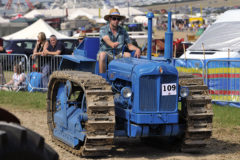Blue Funnel’s Centaur to Singapore
Posted by Chris Graham on 9th May 2022
Jim Shaw recalls a voyage taken on Blue Funnel’s Centaur to Singapore in the 1970s, and the ships seen off the ‘Lion City’ in that decade.

One of the world’s best known passenger/cargo liners of the 1960s and 1970s, the 8,262grt Centaur, operated between Western Australia and South East Asia from 1964 until 1982, after which she undertook a one-year charter between South Africa and Great Britain for the St Helena Shipping Co, before being sold to the China Ocean Shipping Co (COSCO) in 1985. (Pic: C Gee)
Five decades ago there were still a number of passenger ships trading between Fremantle, Australia, and the island nation of Singapore, where relatively cheap charter and scheduled air flights could be obtained to onward destinations. Towards the end of the 1970s, I took advantage of the situation by booking passage on Blue Funnel’s Centaur, following an overland journey by train from Sydney.
The one-way fare in a four-berth cabin on B-Deck at the time was A$290 and I found that, by paying an extra A$10, I could board the ship on the evening of my arrival, dinner included, before departure for Singapore the following day.
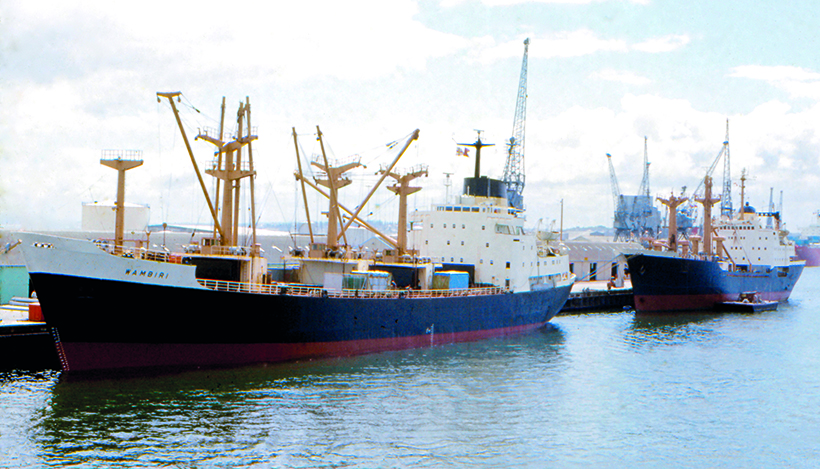
On departure from Fremantle, several ships were left behind, including the State Shipping Service’s 5,149grt Wambiri, completed in 1963 as Cunard’s Parthia, and Boogalla, Poseidon Linien’s former 1966-built Transmichigan, both sold prior to the winding-up of the state-sponsored Australian shipping concern in the 1990s. (Pic: Jim Shaw)
Centaur was a unique ship. I was somewhat surprised the following morning when lorries began arriving with hundreds of sheep, all making their way into the lower decks over gangways, while arriving passengers were soon doing the same several decks above. After talking to the chief purser, I found Centaur had been completed in 1964 by John Brown & Co, Clydebank, as a replacement for two older ships; the pre-war-built twins Charon and Gorgon, which were then retired.
Centaur herself had been designed to carry not only passengers and cargo but also livestock, and her hull, like those of her predecessors, had been strengthened to allow her to rest on the mudflats of tidal ports in northwestern Australia.
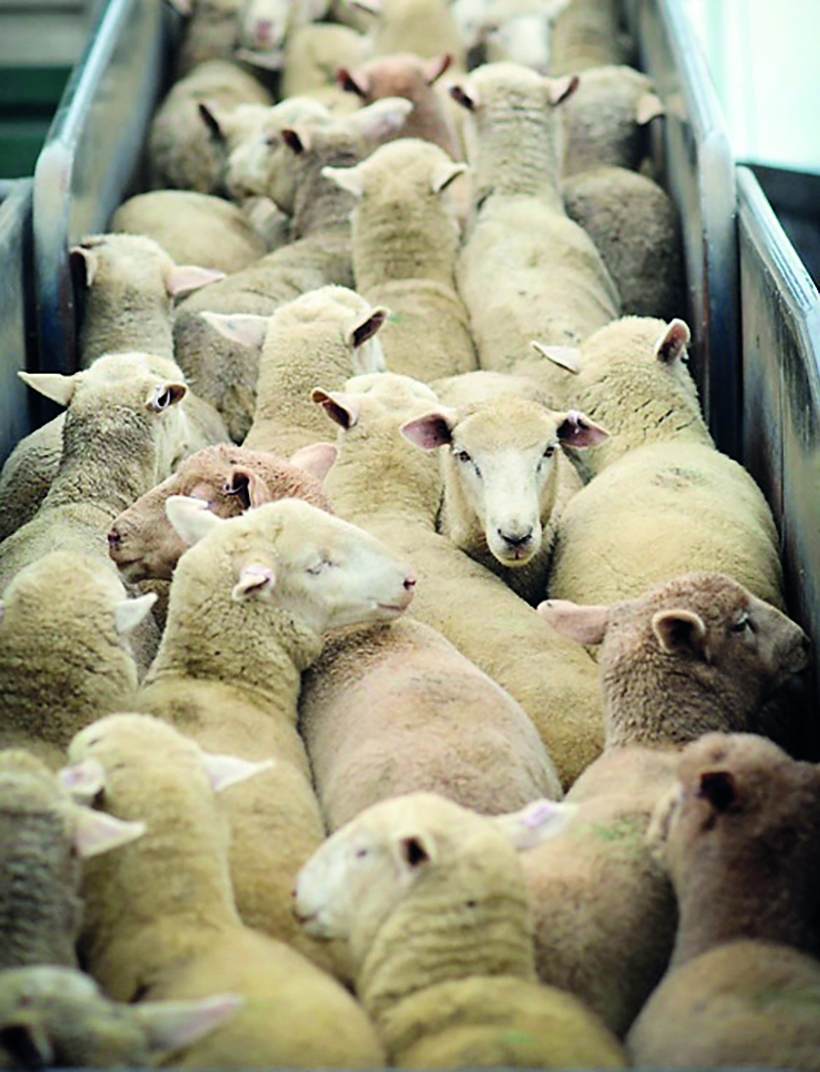
Perhaps unwilling passengers, sheep were one of Centaur’s main money-earners, and 4,500 of the animals could be accommodated in two-tier pens on the lower decks, which were ventilated through the open hatches. (Pic: SPA)
However, the coastal trade had been given up several years earlier and, by her second decade of service, Centaur was beginning to feel the impact of containerisation and air travel, along with competition from other vessels. These included the Russian twins Felix Dzerjinsky and Turkmenia, operated on a seasonal basis under charter by CTC Line, and Pacific International Line’s Kota Bali and Kota Singapura, formerly the Dutch twins Twijangi and Tjiluwah which, like Centaur, were capable of carrying livestock on their lower decks.
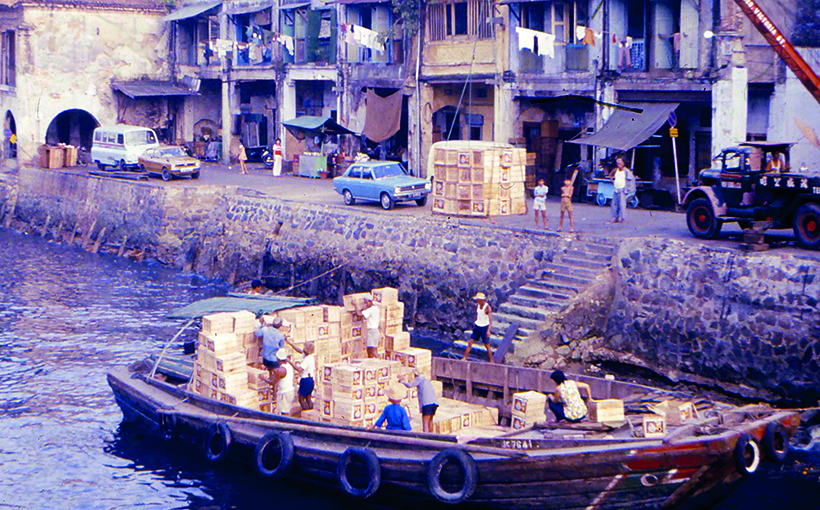
Much of the cargo handled by ships anchored off Singapore in the 1970s was moved to or from godowns located on the Singapore River by wooden-hulled bumboats, all of which were painted with ‘eyes forward to see dangers ahead’. (Pic: Jim Shaw)
Travel route
At the time of my passage, Centaur was sailing from Fremantle about every three weeks on a 17-day round trip that carried her through the Sunda Strait to Singapore, then on up the Malacca Strait, to both Port Klang and Georgetown.
On this cruise-like circuit all round-trip passengers were given two-and-a-half-days on the upward journey and one-and-a-half days on the southbound trip, to do sightseeing and shopping in Singapore while the vessel loaded and discharged her cargo. Day excursions were also available in Port Klang and Georgetown, while the ship was being handled and, at times, Centaur would divert to Christmas Island to drop off and pick up mail.
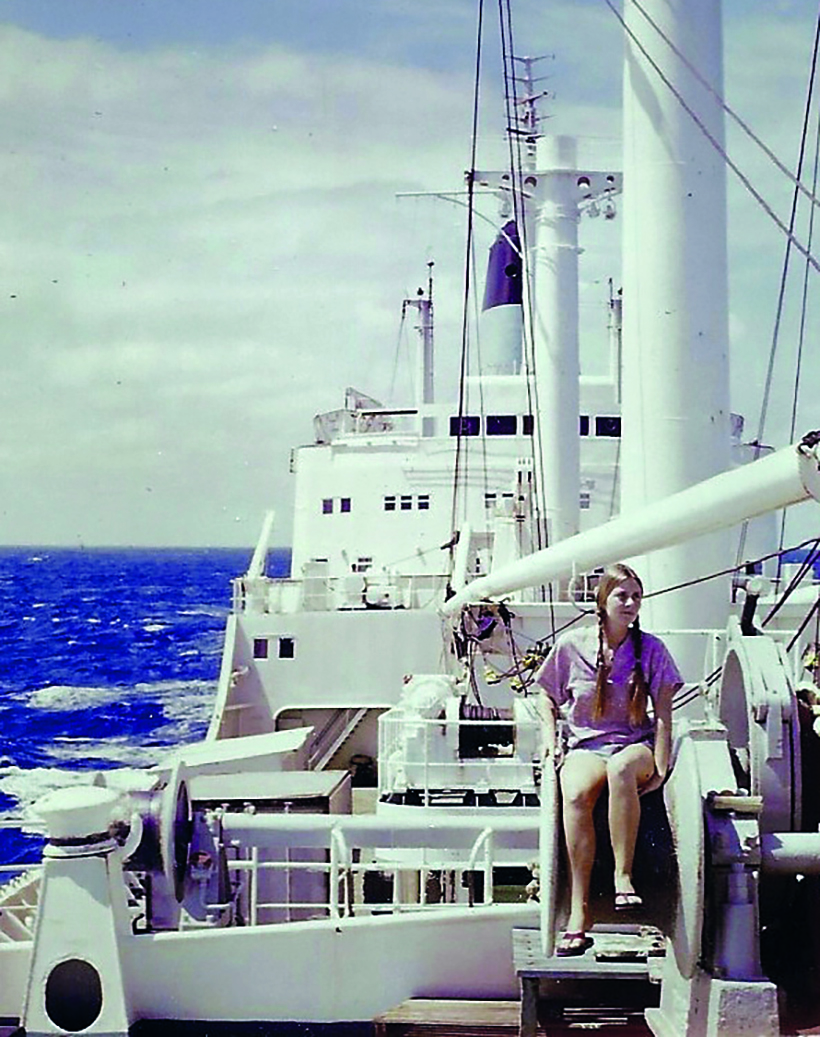
Passengers were still allowed on Centaur’s working decks in the 1970s, either to inspect the livestock through the open hatchways or have their picture taken forward as the ship sailed through the Indian Ocean. (Pic: Jim Shaw)
Accommodation
Passenger accommodation on Centaur varied from twin-bed suites located on A deck, where a library/card room was located forward and a bar/lounge and shop aft, to four-berth cabins without facilities on B-deck, the latter also containing the hospital and doctor’s office forward and the centrally located Purser’s bureau. The dining room, laid out in an ‘H’ pattern, was located aft on C deck, and was decorated by a line drawing of Centaur and her former namesakes, by Laurence Dunn.
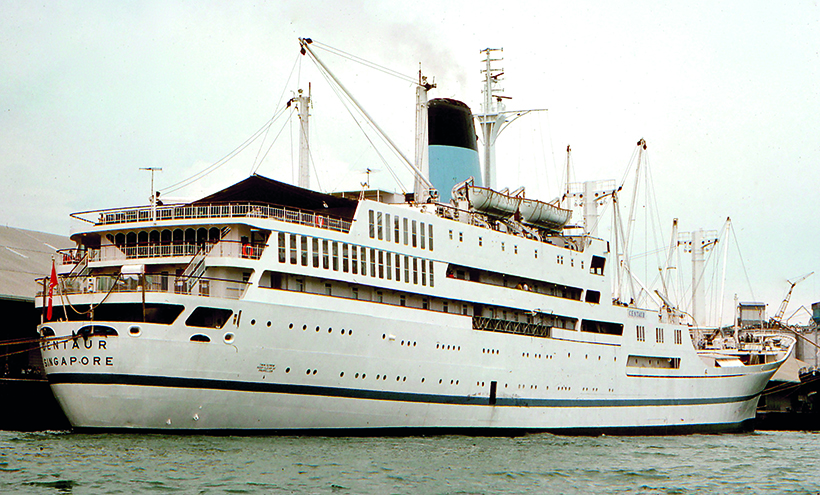
At Singapore, Centaur traditionally landed her cargo of livestock at the Jurong wharves, before proceeding to her berth in Keppel harbour. This stern view shows the tarp that was normally rigged to protect the swimming pool area from rain or sun. (Pic: Mark Mulligan)
Outside this room was a small casino harbouring a collection of very unsympathetic ‘one-arm bandits’, but a popular gathering point before and after meals. There was also a small launderette on board, which eluded many passengers because of its location, tucked away between cabins, and a children’s room with outside play deck. The swimming pool area, located at the aft end of A deck and opened to the main lounge in good weather, became a popular spot once the Tropic of Capricorn was passed and Centaur proceeded into the tropics.
Cargo decks
In the 1970s, passenger access was still available to the ship’s working decks and many people, especially those with farms in Australia, liked to carry out a morning inspection of the livestock being carried, all easily visible through the open hatchways. Besides the hatches, which were only closed during inclement weather, venting for the livestock was accomplished by using large suction fans, which changed the cargo hold air 30 times per hour and vented the exhaust through the two hollow main masts.
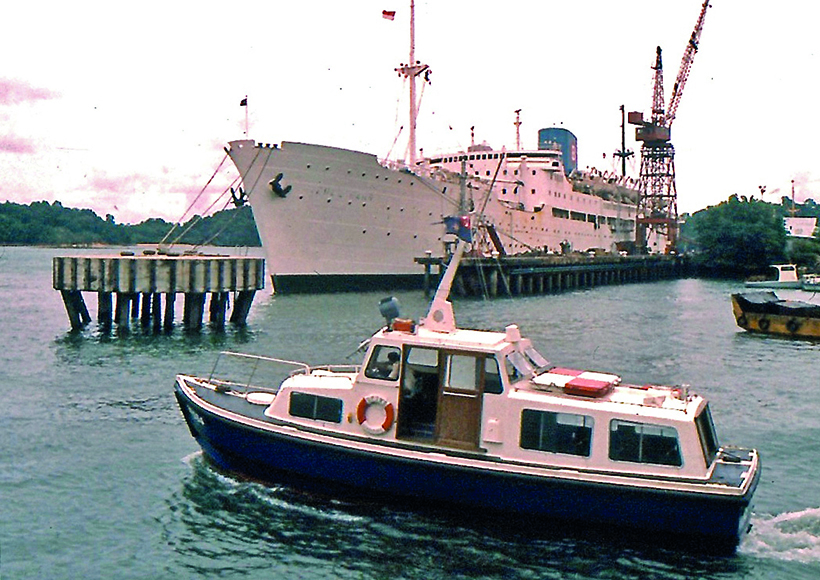
Another passenger-carrying ship often seen at Singapore in the 1970s, and one that operated to Fremantle for several years as Eastern Queen, was the former French liner General Mangin, later to become Bangladesh Shipping Corporation’s Hizbul Bahr. (Pic:Jim Shaw)
The livestock spaces were specially designed to provide double-tiering for sheep and single-tiering for cattle, although cows were seldom carried. However, on this trip 170 breeding cattle were on board, along with 1,600 sheep. Besides her passengers and livestock, Centaur also transported frozen meat, machinery, potatoes and fruit northbound, while limited amounts of Chinese foodstuffs, tropical fruits, lumber and veneer were carried south.
A tight schedule
Because of her tight schedule, Centaur had been fitted with two, 11-cylinder, 8,250hp B&W turbocharged diesels driving twin propellers to give a speed of 18 knots. A tour made of the engine room with the second engineer disclosed four auxiliary diesels driving 50kW alternators located forward of the main engines. These provided the ship’s electrical supply and powered more than 265 electric motors on board, as well as the refrigeration machinery.

One of the oldest ships at Singapore in the 1970s – but to be retired and scrapped by the end of the decade – was the training ship Singapore, completed by Britain’s Workman Clark as Strait Steamship’s Marudu in 1924, and converted for training purposes in the 1960s. (Pic: Mark Mulligan)
The sewage plant and firefighting pumps were located aft of the main engines, while an emergency genset was found on the boat deck just behind the funnel, where controls for CO2 flooding and firefighting were also located. Courtesy of my guide, I was also shown the officer’s lounge/bar, which was situated just above the main lounge and overlooked the swimming pool area.
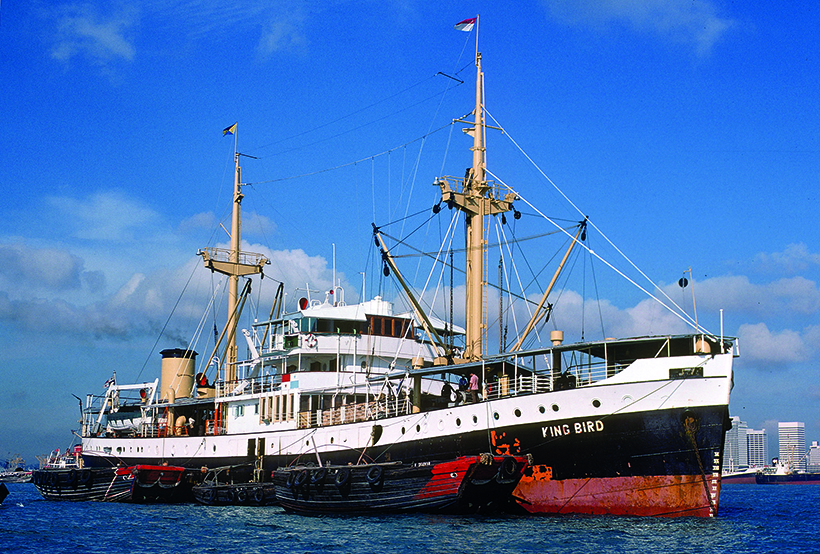
One of the many small ships served by bumboats off Singapore was the Panama-registered King Bird, a 1,331grt inter-island vessel built by Rotterdamsche Droogdok Mij as KPM’s Batoela in 1947 and broken up at Jurong in 1983. (Pic: D Brown)
Because of the wide diversity of crew and passengers on board, there were three galleys capable of providing Chinese meals for much of the steward staff, Malaysian dishes for most of the seamen and European cooking for officers and passengers, although the latter were also able to taste some of the Asian specialities from time to time. The livestock also dined well, as over 18 tons of special feed and hay was loaded at Fremantle, the actual amount depending upon the number of animals being carried.
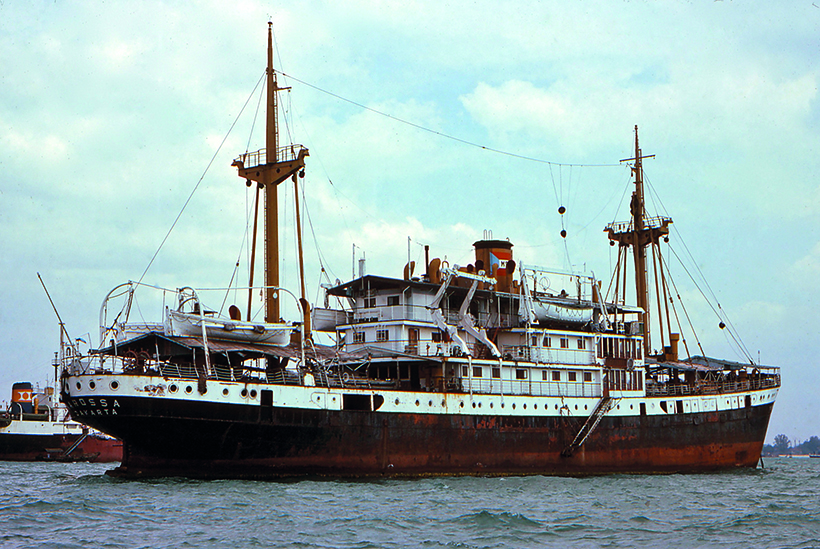
A former Dutch ship never renamed was the 2,149grt Karossa, completed at Amsterdam in 1948 and surviving under that name through her days of Indonesian ownership until broken up at Surabaya in 1985. (Pic: Mark Mulligan)
Sunda to Singapore
Our northbound passage in the Indian Ocean took us through Sunda Strait and into the Java Sea, where we continued along the east coast of Sumatra. Traffic intensified and we were soon passing, or being passed by, a large number of ships, several of which appeared to be old Koninklijke Paketvaart-Maatschappij (KPM) inter-island vessels. One of these was the slow-moving Ogan, which we overtook off Banka Island and, which later research disclosed, was KPM’s former Kalianget of 1948.

Something of an oddity in the Singapore anchorage was the 1,964grt Hong Eng, a former Dutch ship completed in 1955 as Prins Casimir for Oranje Lijn’s service into the St. Lawrence River, and lengthened in 1960 following the opening of the new St. Lawrence Seaway, but broken up as Seree 2 in 1987. (Pic: D Brown)
More of these ancient ships were seen upon our arrival at Singapore, where Centaur first discharged her load of livestock at the Jurong wharves before threading her way through the anchorage to take up a berth in Keppel Harbour. Following disembarkation, I had a full day available before my flight out of the city’s old Paya Lebar Airport.
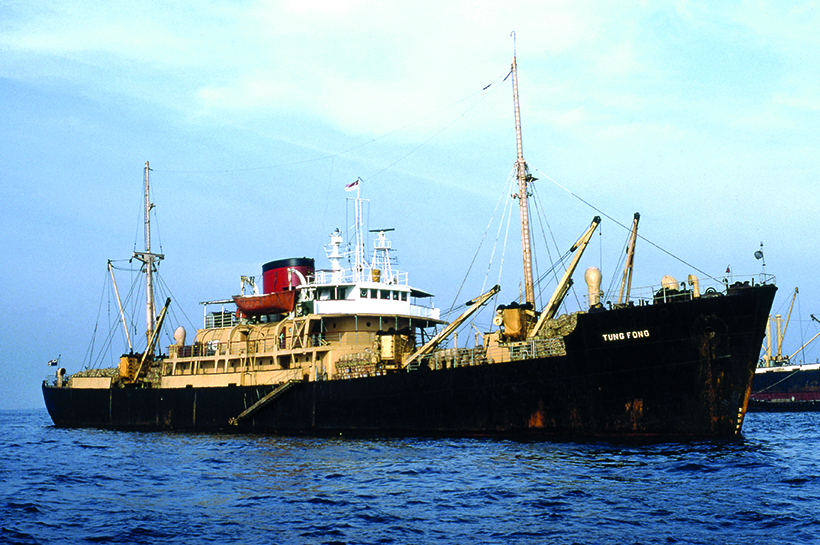
A diminutive vessel with an interesting history, the 2,067grt Tung Fong had been built for London’s Halal Shipping Co by the Ardrossan Dockyard as El Kerym in 1950, and sailed as Straits Steamship’s Kinabalu from 1956 to 1970, but was dismantled in 1979. (Pic: D Brown)
This allowed a visit to the Chinese godowns along the Singapore River and their attendant bumboats, as well as a tour out to the anchorage area from Clifford Pier. The latter contained a vast collection of ships of the period, all gone now, as is Centaur, which was retired in 1982 after operating an unsuccessful 25-day cruise circuit that included calls at Manila and Hong Kong.
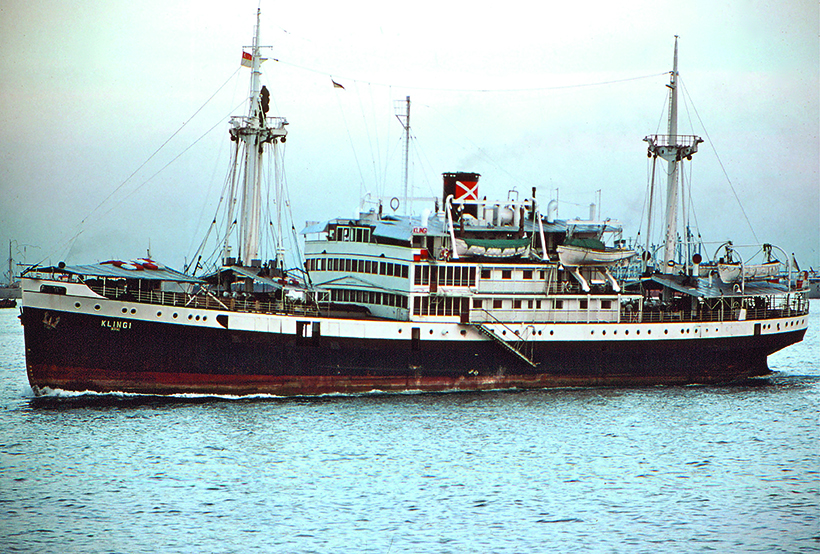
A ship that went on to sink another ship, the 2,169grt Klingi was built in 1947 as KPM’s De Eerens and, after being sold to Indonesia in 1962, sank off Jakarta in 1977, where her unmarked hull was later hit by the outbound Sitmar passenger vessel Fairsky, which sank. (Pic: Mark Mulligan)
After a one-year charter to the St Helena Shipping Co, and several years of lay-up at Singapore, the British-built combination liner was sold to China’s COSCO in 1985, and demolished two decades later at Guangdong, China as Hai Da.

A vessel with a long list of owners, the 1,331grt Messina had been built for the Dutch government as Balanipa in 1947 and, after being sold in 1960, traded as Selat Makassar, Anna, Annam, Batina, Messina, Mesinga. Mulia and Hi-Calibre before being broken up at Singapore in 1984. (Pic: D Brown)
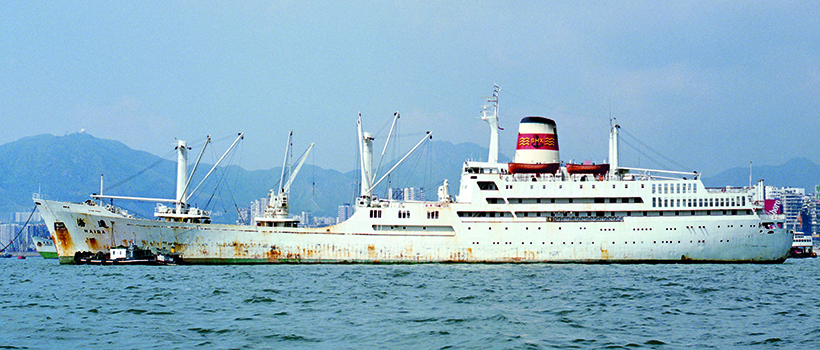
Following Centaur’s sale to COSCO in 1985, the ship sailed for another two decades as Hai Da between Shanghai and Hong Kong, before being demolished in China sometime prior to 2007. (Pic: H Hoffman)
This feature is from the latest issue of Ships Monthly magazine, and you can get a brilliant, money-saving subscription simply by clicking HERE




